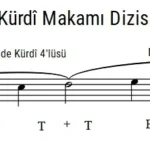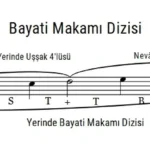Hüseynî: A mode and a pitch within Turkish Music, counted among the simple makams
Hüseynî Ney Taksimi – Süleyman Yardım
The final note is Dügâh (A).
It follows an ascending-descending structure.
Formed on the Dugâh pitch by combining the Hüseynî pentachord with the Uşşak tetrachord at Hüseynî
In the Hüseynî mode, especially in descending melodies, the allure of descent may lead to the use of the Acem (F natural) pitch instead of Eviç (F♯). This substitution forms a Kürdî tetrachord on the Hüseynî pitch, resulting in what is called the Acem-inflected Hüseynî scale.

It is the Hüseynî pitch at the junction of the Hüseynî pentachord and the Uşşak tetrachord. A half cadence is made here with the Uşşak flavor. (If the melody descends from Tîz Bûselik, a Hüseynî pentachord forms at Hüseynî.)
The most prominent and characteristic suspended cadence pitch in the Hüseynî mode is Çârgâh. When the Acem-inflected Hüseynî scale is used—meaning Acem replaces Eviç—the suspended cadence at Çârgâh is made with the Çârgâh flavor, a hallmark of the mode. If, rarely, descent occurs via Eviç, the cadence at Çârgâh reflects the Pençgâh pentachord.

The second most significant suspended cadence pitch is Segâh. Cadences here are made using Segâh and Ferahnâk flavors or the Segâh triad. If the Acem-inflected Hüseynî scale is employed—meaning descent occurs via the Acem pitch—then the cadence reflects the incomplete Segâh and Ferahnâk flavors, which nearly amount to a modulation into the Uşşak mode.


The third most important suspended cadence pitch is Nevâ; when the scale employs Eviç, Râst flavors emerge on this pitch, whereas in the Acem-inflected Hüseynî scale—descending via Acem—Bûselik flavors are formed on Nevâ.

A suspended cadence may also be made on the Râst pitch using the Râst pentachord.
The key signature includes a 1-comma flat for B (Si) and a 4-comma sharp (bakiye) for F (Fa)
Dügâh (A), Segâh (B lowered by 1 comma – approximately B double flat), Çârgâh (C), Nevâ (D), Hüseynî (E), Eviç (F), Gerdâniye (G), and Muhayyer (A) correspond to the following notes.
It is the G (Sol) pitch on the second line (Râst).
The Hüseynî pentachord on the tonic is symmetrically transposed onto the high register Muhayyer pitch, resulting in a symmetrical expansion.

Additionally, by adding a Bûselik pentachord on the Muhayyer pitch to the Uşşak tetrachord on the dominant Hüseynî pitch, a Uşşak Makam scale is constructed within Hüseynî . (Expansion through creation of a new scale)

he melodic progression begins around the dominant Hüseynî pitch. Even if it occasionally starts from the tonic, it quickly gravitates toward the dominant. After wandering through the flavors that form the scale, a half cadence with Uşşak flavor is made on the dominant Hüseynî pitch. Meanwhile, auxiliary cadences are shown where necessary. Again, after a mixed wandering through the scale, the expanded section may optionally be displayed, and a full cadence is made on the Dügâh pitch using the Hüseynî scale.






